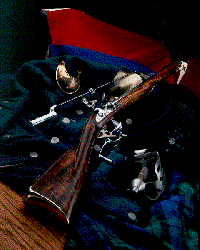

The Milwaukee Public Museum—Ferguson Rifle: A Revolutionary
Firearm
Ferguson Rifle: A Revolutionary Firearm
REVOLUTIONARY WAR RIFLE ON DISPLAY IN MUSEUM EXHIBIT
The Brilliance of the Design
Invented by British Army officer Patrick Ferguson in 1774, the
Ferguson Rifle loaded from the breech instead of the muzzle,
eliminating the clumsy and time-consuming ramrod system that
limited a soldier to three shots per minute and required him
to load and discharge his weapon while standing upright.
The new rifle allowed a soldier to load with a couple turns of
a screw and fire with great accuracy while prone or walking.
It was, by every conceivable measure, superior to anything
that had come before it.
"The latest research says the Ferguson was a better weapon
than people even thought, and undoubtedly pointed the way to
future rifles," Lundstrom said.
In fact, the quick-loading rifle was such an improvement over
rifles of the time that some argue it could have changed the
way 18th-century wars were fought. Its long-range accuracy
could have rendered close-range muskets nearly useless, and
eradicated the bayonet fighting that followed initial musket
volleys.
"It’s not hyperbole to say that the Ferguson Rifle—and
Ferguson himself—was 50, even 75 years ahead of its time,"
Lundstrom said. "We can imagine, had the British fully grasped
the significance of this rifle, an entirely different type of
warfare, and, quite possibly, a different outcome to the war."
Ferguson officially unveiled his rifle to England’s King
George in a series of tests in 1776. Ferguson accurately fired
in heavy rain and high wind, while walking toward a target 200
yards away and while lying on his stomach. His nearly flawless
performance so impressed King George that he commissioned 100
rifles to be crafted and tested in battle against American
patriots.
The one real test the rifle was given—at the Battle of
Brandywine, Penn. in 1777— ended abruptly when Ferguson was
badly wounded. The rifle would be given cursory trials in a
handful of other battles, but was never given another extended
opportunity.
Ferguson and the rifle were inextricably linked: because he
alone possessed sufficient knowledge to operate and utilize
the weapon, his death—at Kings Mountain, S.C. in 1780—meant
the death of the rifle as well.
"People weren’t ready for this rifle, or Ferguson’s idea,"
Lundstrom said. "We can look back and see the importance of it
today. It was a completely different way to conceptualize a
rifle."
The Museum’s Artifact
The Museum’s Ferguson Rifle came to the Museum in 1900 in the
collection of benefactor Rudolph Nunnemacher. The .65 caliber
rifle is 49 inches long, with a 34-inch barrel.
Because it bears no external marks indicating country of
origin, it was first thought to be German, but soon was
identified as a Ferguson. Experts believe the rifle was
captured by an American patriot from the British. The patriot
probably rubbed off the crown etching on the Ferguson’s rifle
lock that identified it as a British weapon to protect himself
in the event he was captured by the British Army, who hanged
those caught fighting with British weapons.
The only other officially issued Ferguson Rifle known to exist
is owned by the Morristown National Historical Park, New
Jersey.
In the Museum exhibit, the Ferguson will be presented next to
a .75 caliber British smoothbore musket called a Brown Bess,
dating to 1759. This long-land musket was the standard British
weapon at the beginning of the Revolutionary War.
Diagrams in the exhibit will contrast the breech-loading
design of the Ferguson with the Brown Bess’ muzzle-loading
apparatus.
©2000 Milwaukee Public Museum. All rights reserved